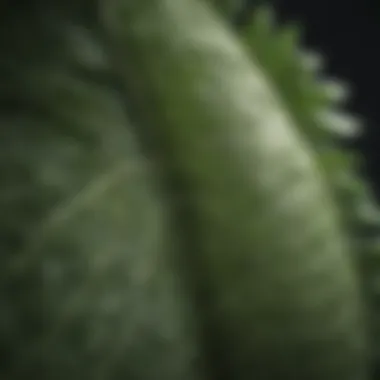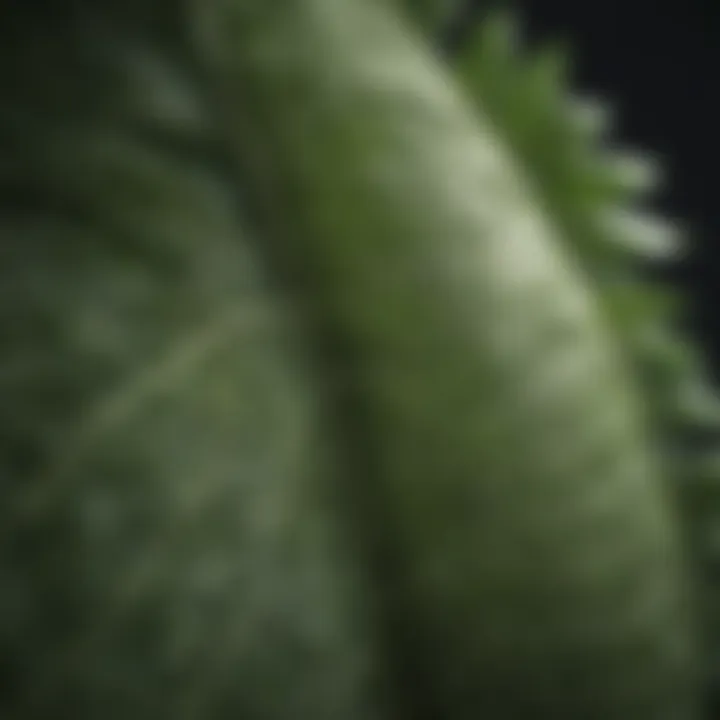Exploring the Beauty and Function of Tropical Plant Leaves


Intro
Tropical plant leaves offer an impressive display of diversity and beauty. These leaves can transform any indoor space, enhancing its aesthetic while contributing to the well-being of the environment. Understanding the unique characteristics of tropical foliage is essential for homeowners and gardening enthusiasts alike.
The appeal of tropical leaves lies not only in their looks but also in their adaptability and importance within ecosystems. They possess distinct features such as size, shape, and texture, which can influence their growth in various settings. This article will explore these attributes in detail, providing insights into how to care for these plants and incorporate them into your home decor.
The role of tropical plant leaves in interior design cannot be overlooked. As more people seek ways to bring a touch of nature indoors, the vibrant hues and striking forms of these leaves become essential elements in creating a visually compelling atmosphere.
Design Inspirations
When considering how to use tropical leaves in design, one must think about the styles and colors that appeal to modern sensibilities. Tropical leaves can play a crucial role in various design frameworks, offering inspiration that transcends cultural boundaries.
Trending Styles
Numerous design trends incorporate tropical foliage. For example,
- Biophilic Design: This approach emphasizes a connection to nature, and tropical plants fit perfectly within this concept. Incorporating large, leafy plants like Monstera or Philodendron can create a soothing environment.
- Maximalist Decor: Bold patterns and colors dominate this design style. Leverage the vibrant greens and unique shapes of tropical leaves to complement or contrast with patterned wallpaper or textiles.
These styles demonstrate how tropical leaves can enhance both functionality and aesthetics in living spaces.
Color Palettes
Tropical plants exhibit a range of colors, which requires careful thought when designing interiors. A well-considered color palette can elevate the overall look of a room. Some suggestions include:
- Lush Greens: Utilize various shades to create a harmonious look. Pair lighter greens with deep forest hues for depth.
- Accent Colors: Consider using tropical plants with flowers or patterned leaves that introduce bright colors, such as red or yellow, to create focal points.
- Neutrals and Earth Tones: Combining foliage with these colors can soften the vibrant tones, creating a balanced atmosphere.
By selecting thoughtfully designed color combinations, homeowners can maximize the effect of tropical leaves in their interiors.
Maintenance and Upkeep
Caring for tropical plants requires attention. Here is a concise list of practices to maintain their health and beauty.
Seasonal Maintenance Checklist
- Spring: Prune dead or yellowing leaves to encourage new growth.
- Summer: Water more frequently as plants experience increased transpiration.
- Fall: Reduce watering as light levels decrease, and prepare plants for dormancy.
- Winter: Check for pests regularly, as this is a common issue during colder months.
Cleaning and Organization Tips
- Clean the leaves regularly using a damp cloth to remove dust. This practice enhances photosynthesis and prevents pests.
- Organize plants by size or light requirement. Grouping similar plants can simplify care and create pleasing visual arrangements.
"An effective maintenance routine is integral to ensuring the vibrancy and longevity of tropical plant leaves in any indoor setting."
Understanding Tropical Plant Leaves
Tropical plant leaves are fundamental to our understanding of botany and ecology. They symbolize the diverse ecosystem that thrives in warmer climates. This section serves as a foundation for comprehending the multifaceted roles these leaves play in both natural habitats and human design.
Defining Tropical Plants
Tropical plants are defined by their adaptation to tropical climates. These regions, situated near the equator, are characterized by warm temperatures and high humidity. Typical examples include palm trees, orchids, and hibiscus. These plants often exhibit broad leaves which facilitate transpiration and maximize photosynthesis, crucial for survival in their resource-rich environments. Understanding the types of tropical plants is essential for grasping their ecological roles and cultivation needs.
Unique Features of Tropical Leaves
Tropical leaves exhibit remarkable traits that distinguish them from other plant types. One key feature is their size; many tropical leaves are significantly larger than those found in temperate regions. This adaptation enables them to capture more sunlight, essential in dense forests where light is often limited. Additionally, tropical leaves often have a glossy surface, which helps in reducing water loss. Some tropical species, such as the giant Amazonian lily, even possess intricate patterns and structures that enhance their ability to support diverse ecosystems by providing habitats for various organisms.
Importance in Ecosystems
The ecological functions of tropical leaves are profound. They contribute fundamentally to photosynthesis, absorbing carbon dioxide and releasing oxygen. This gas exchange is vital to maintaining atmospheric balance and supporting life on Earth. Furthermore, tropical leaves provide essential habitats and food sources for many species. They are integral to the life cycles of various insects, birds, and other wildlife.
"The diverse shapes, sizes, and functions of tropical leaves are crucial for sustaining life in their ecosystems."
Moreover, as tropical regions face increasing environmental stress, such as climate change, the health of tropical leaves directly impacts biodiversity. Their role in soil stabilization and water retention cannot be overstated; they help mitigate erosion and maintain nutrient cycles. Thus, understanding tropical leaves is not only vital for botanical enthusiasts but also for anyone concerned with sustainable practices and conservation efforts.
Morphological Characteristics
The study of morphological characteristics is essential in understanding tropical plant leaves. This section examination offers insights into how structure, shape, and coloring of leaves relate to their functions. Recognizing these features allows homeowners, gardening enthusiasts, and professionals to appreciate the unique benefits tropical leaves bring to various spaces. Furthermore, it aids in effective cultivation practices and sustainable landscaping, directly linking to the aesthetic and ecological values of tropical foliage.
Leaf Structure and Formation
Tropical leaves exhibit a multitude of structural designs, each adapted to their specific environments. The leaves are typically broad and flat, which enhances their surface area for maximizing light capture. This characteristic supports efficient photosynthesis, especially under the canopy of dense rainforests where light is limited. The arrangement of veins in the leaf, known as venation, plays a critical role in water transport and structural integrity. For example, a pinnate venation pattern allows for impressive support while maintaining flexibility.
In addition, the internal cellular structure is optimized for gas exchange. Stomata, the tiny openings on the leaf surface, have a unique arrangement that enables better regulation of water loss and gas intake. This regulation is vital, given the high humidity levels in tropical regions. Understanding this formation helps gardeners in selecting the right species for their environments and managing watering effectively.


Variations in Leaf Shape and Size
Tropical plant leaves are not uniform. They come in various shapes and sizes, which can indicate how a plant adapts to its ecosystem. For instance, large, broad leaves are often found in species that thrive in low-light conditions, such as the Monstera deliciosa. In contrast, smaller, lobed leaves may be seen on plants exposed to high wind conditions, minimizing damage and moisture loss.
The differences also serve aesthetic purposes. Homeowners interested in interior design can mix various shapes to create visually appealing arrangements. For example, a combination of the broad leaves of a Philodendron with the delicate fronds of a Neoregalia can add texture and depth to indoor spaces. Knowing these variations allows for more informed choices in plant selection.
Coloration and Patterns
Coloration and patterns of tropical leaves are not just aesthetic attributes; they have practical implications as well. The colors can signify the plant's health and indicate how it is adapting to environmental factors. For example, vibrant green hues often indicate healthy chlorophyll levels, essential for photosynthesis. Meanwhile, variations like reddish or purple tinges can suggest stress or adaptation to light intensity.
Patterns, such as variegation, can enhance visual interest. Variegated leaves often attract attention and can be a focal point in decor. Additionally, some leaves display mottled patterns or distinct markings, which may serve camouflage in the wild, protecting the plant from herbivores. For design purposes, such visual diversity allows homeowners and designers to create unique and vibrant spaces.
"Understanding leaf characteristics enriches our appreciation for tropical plants and their vital roles in both nature and aesthetics."
By examining the morphological traits of tropical plant leaves, we gain insight not only into their functionality but also their beauty. This understanding fosters a deeper connection to these unique plants, empowering better choices in their cultivation and incorporation into various environments.
Photosynthesis in Tropical Plants
Photosynthesis holds immense significance in the life cycle of tropical plants. The process serves as a natural mechanism for converting light energy into chemical energy, forming the foundation of food webs in tropical ecosystems. Leaves, as the primary site for this process, adapt specifically to thrive in the warm, humid conditions typical of tropical climates. Understanding how these processes work is vital for anyone interested in growing tropical plants.
The Role of Leaves in Photosynthesis
Tropical leaves have a unique structure and composition that facilitate efficient photosynthesis. The leaf's surface is often broad and flat, which maximizes exposure to sunlight. The upper layer of cells, called the palisade mesophyll, contains numerous chloroplasts, where the magic of photosynthesis occurs.
Chlorophyll within these chloroplasts captures sunlight, utilizing it to convert carbon dioxide and water into glucose and oxygen. This glucose serves as an energy source for the plant, while oxygen is released as a by-product. This process not only sustains the plant itself but also contributes to the overall oxygen levels in the environment.
"Leaves are nature's solar panels, adept at capturing sunlight and transforming it into energy required for life."
Adaptations for Light Capture
Tropical plants have evolved various adaptations to optimize light capture. For instance, some species exhibit leaf inclination, ensuring that they can catch more sunlight even when competition from nearby plants is intense. Others may have reflective surfaces, minimizing light loss.
Additionally, many tropical plants have developed the ability to change their leaf orientation throughout the day, aligning themselves with the sun's position. These strategies significantly enhance photosynthesis efficiency, essential in the dense canopies of tropical forests, where light is at a premium.
Impact of Humidity and Temperature
Humidity and temperature play critical roles in photosynthesis for tropical plants. Tropical environments are characterized by high humidity, which facilitates the absorption of water through leaves. This is essential since water is one of the key components needed for photosynthesis.
Temperature also influences the rate of photosynthesis. Tropical plants generally thrive in warm conditions, but they have optimal temperature ranges. Excessive heat can lead to enzyme denaturation, slowing down metabolic processes. Conversely, not enough warmth can lead to reduced photosynthetic efficiency. Overall, the interplay between humidity, temperature, and light is crucial for the healthy growth of tropical plants.
Growing Tropical Plants at Home
Growing tropical plants at home has become a popular hobby for many homeowners, interior design enthusiasts, and gardening aficionados. These plants bring a unique vibrancy and an exotic feel into living spaces. Their lush foliage adds a certain character that artificial decor simply cannot replicate. Not only do tropical plants enhance aesthetic appeal, but they also improve indoor air quality, creating a more pleasant environment.
The benefits of cultivating tropical plants at home include:
- Air Purification: Many tropical plants are known for their air-cleaning properties, removing toxins from the air.
- Aesthetic Appeal: The vibrant colors and lush textures of tropical leaves can transform any space.
- Mood Enhancement: Being around greenery has been scientifically shown to reduce stress and promote well-being.
However, growing these plants requires attention to certain factors. Not every plant thrives in every environment, so understanding the specifics is key.
Choosing the Right Tropical Varieties
Not all tropical plants will suit your home. It’s essential to consider your living conditions before selecting varieties. Some plants thrive in low light while others need abundant sunlight. When choosing tropical plants, take into account your home’s lighting conditions, humidity levels, and space availability.
Popular tropical varieties to consider include:
- Philodendron: Adaptable to various light conditions and can grow as a climbing or trailing plant.
- Monstera Deliciosa: Known for its large, dramatic leaves and ability to thrive in indirect light.
- Peace Lily: Prefers low light, making it suitable for dimmer areas and produces lovely white flowers.
Selecting the right variety will ease the cultivation process and ensure beautiful results.
Optimal Soil and Water Requirements
Soil and water requirements are crucial for healthy tropical plants. Generally, these plants prefer well-draining soil enriched with organic matter. Soil mix should retain moisture without becoming waterlogged. A typical blend often incorporates peat moss, perlite, and compost.
Watering guidelines include:
- Frequency: Water when the top inch of soil feels dry, as tropical plants prefer consistently moist soil but can be sensitive to overwatering.
- Quality: Use distilled or rainwater when possible, as tap water may contain chemicals that could affect plant health.
Understanding these requirements promotes strong growth and vibrant foliage.
Light and Temperature Considerations
Light and temperature play a significant role in the health of tropical plants. Most tropical varieties thrive in bright, indirect sunlight. Direct sunlight can scorch leaves, while too little light causes stunted growth.


Key points for managing light include:
- Placement: Position plants near east or west-facing windows for optimal light exposure without burning their leaves.
- Artificial Lighting: In rooms with limited natural light, consider using grow lights to supplement.
Temperature is another factor to monitor. Tropical plants generally prefer temperatures between 65°F to 85°F. Sudden changes in temperature or exposure to cold drafts can stress the plants.
"Creating a suitable environment for your tropical plants is essential for their growth and longevity."
By paying attention to these details, homeowners can successfully integrate tropical plants into their spaces, enriching their homes with beauty and life.
Aesthetic Uses of Tropical Leaves
The aesthetic uses of tropical leaves extend far beyond mere decoration; they embody a blend of art, nature, and environmental consciousness. In this section, we will explore how these vibrant natural elements contribute to various design settings, highlight their benefits, and discuss important considerations. Tropical leaves provide not just beauty but also functionality in both indoor and outdoor environments. Their distinct forms and lush colors stimulate creativity and can transform spaces from ordinary to extraordinary.
In Interior Design
Tropical leaves have gained immense popularity in interior design. Their bold shapes and rich hues add life to various settings. A few specific elements can significantly impact the overall aesthetic of a room:
- Design Versatility: Whether used in wall art, as standalone plants, or part of larger floral arrangements, tropical leaves fit seamlessly into different styles, from modern to bohemian.
- Color Accents: The green shades of tropical foliage can contrast beautifully with neutral tones, bringing vibrancy to muted spaces.
- Textures: The unique textures of leaves, like those of the monstera or philodendron, can add depth and dimension to flat surfaces.
Interior designers often use large, exotic leaves like those of the monstera plant to create striking focal points. These elements can ground a space and bring a touch of the exotic indoors. Careful placement of tropical plants or leaves can also improve room acoustics, helping to absorb sound and enhance the comfort of interiors.
In Outdoor Spaces
The use of tropical leaves in outdoor design is equally compelling. They can create lush, inviting landscapes that evoke an escape to a tropical paradise. Key elements of outdoor aesthetic include:
- Layering and Depth: Tropical plants can be layered to create green privacy screens or living walls, enhancing not only beauty but also functionality in urban settings.
- Climate Benefits: Strategically placed tropical foliage provides shade and can help cool outdoor areas, making spaces more comfortable during warm months.
- Wildlife Attraction: Many tropical plants serve as natural attractants for local fauna, including butterflies and birds, thus supporting local ecosystems.
Designing outdoor spaces with tropical leaves encourages a symbiotic relationship with nature, inviting biodiversity while enhancing human experience.
Creating Biophilic Environments
Biophilia, or the innate human affinity for nature, is a central theme in contemporary design. Tropical leaves play a vital role in this concept. Using them helps blur the line between indoor and outdoor environments, promoting well-being and a connection to nature. Important considerations include:
- Natural Elements: Integrating tropical leaves evokes a feeling of serenity and calm, which can reduce stress and improve mental health.
- Sustainability: Using locally sourced tropical foliage allows the incorporation of sustainable practices, minimizing the carbon footprint compared to imported styles.
- Cultural Appreciation: Tropical leaves often carry cultural significance, fostering an understanding and appreciation for diverse traditions related to nature.
"Integrating tropical foliage into design not only beautifies a space but also enhances the emotional and psychological health of its occupants."
Challenges in Cultivating Tropical Leaves
Cultivating tropical leaves presents various challenges that gardeners and enthusiasts should know. Understanding these issues is essential for ensuring the health and vibrancy of these plants. Difficulty arises not just from the specific needs of tropical foliage, but also from external factors that threaten their growth. Recognizing these hurdles allows homeowners and gardening aficionados to better prepare and create favorable conditions for these attractive plants.
Common Pests and Diseases
Tropical plants are susceptible to a range of pests and diseases, creating a significant obstacle for growers. Common pests include aphids, spider mites, and mealybugs, which can damage leaves and hinder growth. These pests often thrive in indoor environments where tropical plants are cultivated. Additionally, diseases like powdery mildew and root rot can emerge due to excessive humidity or poor drainage.
To manage these issues effectively:
- Monitor plants regularly for signs of infestation.
- Use insecticidal soap or neem oil when pests are identified.
- Ensure good air circulation to prevent fungal diseases.
Environmental Stress Factors
Environmental factors play a crucial role in the health of tropical leaves. Many tropical plants are sensitive to changes in temperature, humidity, and light conditions. Insufficient humidity can lead to leaf curling and browning, while extreme heat can cause wilting.
Some specific stress factors include:
- Temperature Fluctuations: Tropical plants thrive in stable temperatures. Sudden changes can shock the plants.
- Low Light: Inadequate light can stunt growth and reduce the vibrancy of leaves. Overhead lighting or proper window placement is critical.
- Humidity Levels: Most tropical species require higher humidity. Dry air can lead to numerous growth issues.
Management and Prevention Strategies
Effectively managing and preventing challenges associated with cultivating tropical leaves involves a proactive approach. Homeowners and gardeners should consider the following strategies:
- Regular Monitoring: Inspect plants frequently for pests and signs of disease.
- Controlled Environment: Use humidifiers to maintain optimal humidity levels. Adjust temperature according to the needs of specific plants.
- Soil Management: Choose well-draining soil to prevent root rot and ensure healthy growth.
- Integrated Pest Management (IPM): Incorporate a combination of biological, cultural, and chemical practices to control pests
Implementing these strategies not only safeguards tropical plants but also promotes their overall health. Utilizing a comprehensive approach to navigate the challenges will yield a thriving collection of tropical foliage in any living space.
Tropical Leaves in Sustainable Landscaping
Tropical leaves play a significant role in sustainable landscaping, aligning environmental stewardship with aesthetic appeal. They contribute to a balanced ecosystem, support biodiversity, and enhance the natural beauty of any landscape. Their lush appearance is not just pleasing to the eye but also essential for promoting ecological health. In regions facing ecological disturbances such as biodiversity loss and climate change, the integration of tropical foliage can provide both beauty and functionality.
Promoting Biodiversity
Using tropical leaves in landscaping can actively promote biodiversity. These plants offer habitats and food for various species including birds, insects, and small mammals. For instance, species like the Heliconia are known to attract hummingbirds and butterflies, which are vital for pollination. Additionally, incorporating a diverse selection of tropical plants fosters a more resilient ecosystem.


- Supporting Ecosystems: The presence of various tropical species can help sustain populations of native fauna.
- Creating Microhabitats: Dense foliage provides shade and protection, allowing smaller organisms to thrive.
By creating an environment with abundant tropical leaves, homeowners can contribute to the overall health of local ecosystems.
Enhancing Soil Health
Tropical plants contribute significantly to soil health. Their leaves decompose and enrich the soil, adding organic matter that promotes nutrient retention. Moreover, the root systems of tropical plants help aerate the soil and improve water infiltration. Some tropical species also have symbiotic relationships with soil microorganisms, enhancing nutrient availability.
- Organic Matter Contribution: Decaying leaves improve soil structure.
- Preventing Erosion: The root systems of tropical plants stabilize the soil, reducing erosion risk.
Healthy soil leads to vigorous plant growth, creating a more sustainable and thriving landscape.
Water Conservation Techniques
Tropical leaves can assist in effective water conservation practices. These plants often have adaptations that allow them to thrive with minimal water. For example, many tropical plants develop large leaves that capture sunlight while minimizing water loss through transpiration.
- Xeric Plant Options: Consider plants like the Agave or Yucca, which are highly water-efficient.
- Mulching Benefits: Using tropical leaves as mulch can improve moisture retention in surrounding soil.
Incorporating these techniques not only conserves water but also supports the overall sustainability of a landscape, making it an integral aspect of modern gardening.
"Incorporating tropical leaves in sustainable landscaping enhances both the beauty of the environment and its ecological balance, making it a wise choice for homeowners and designers alike."
Sustainable landscaping with tropical leaves offers a balanced approach to gardening that can lead to beautiful, functional, and environmentally friendly spaces.
Cultural Significance of Tropical Foliage
Tropical foliage holds a profound significance that extends beyond mere aesthetics. In various cultures, these plants serve multiple roles from practical uses to deeply rooted traditions. This section explores the connection between tropical plants and cultural practices, delving into how they shape identities, express spiritual beliefs, and enrich arts.
Tropical Plants in Traditional Practices
In many tropical regions, indigenous peoples have cultivated plants like the banana, taro, and coconut for centuries. These plants are often interwoven into the fabric of daily life. Notably, the leaves of the banana plant are frequently utilized for serving food during ceremonies and gatherings. They are often seen as symbols of abundance, which make them essential for various celebrations. Additionally, many communities use pandan leaves for wrapping food, embracing both function and tradition.
Communities also engage in practices of plant medicine. Various tropical plants hold medicinal properties, recognized and respected by indigenous healers. Knowledge of these plants has been passed down through generations, often central to cultural heritage.
Symbolism in Various Cultures
Symbolism is another key aspect of tropical plants. In numerous cultures, leaves are believed to embody vitality and growth. For example, the palm tree symbolizes peace and victory in many cultures. The cyclical nature of tropical leaves, with their ability to regenerate, mirrors the ideals of resilience and rebirth.
Moreover, different plants carry varying meanings. In South Asia, the sacred fig tree is revered. Its leaves are often connected to spiritual wisdom and enlightenment. This type of significance highlights how tropical plants foster a connection between nature and cultural beliefs.
"Tropical foliage often serves as a reflection of a community's heritage, informing views on life, death, and spirituality."
Use in Art and Design
Art and design have also been greatly influenced by tropical foliage. The vibrant patterns and textures found in tropical leaves inspire artists and designers alike. From botanical illustrations to textile designs, tropical foliage appears recurrently, showcasing its aesthetic versatility.
In contemporary interior design, large leaves such as those from the monstera or philodendron add a touch of nature that is invigorating and refreshing. They bridge the gap between indoor environments and the natural world, making spaces feel alive. Homeowners often incorporate these elements not only for their beauty but also to create soothing atmospheres that encourage well-being.
Architects and landscape designers find inspiration in the functional qualities of tropical foliage, considering how they contribute to ecological sustainability. The incorporation of tropical plants in landscaping helps maintain soil moisture, contributing to efficient water usage.
The Future of Tropical Plant Conservation
The conservation of tropical plants is a pressing issue that carries significant implications for biodiversity and ecological stability. As climate change accelerates, the unique habitats that tropical plants rely on become more threatened. This article examines the future of tropical plant conservation, emphasizing its importance in safeguarding not only individual species but entire ecosystems. By understanding the challenges and potential solutions, we can better appreciate the need for sustainable practices and informed stewardship in tropical landscapes.
Addressing Climate Change Impacts
Climate change poses severe risks to tropical plant species. Shifts in temperature and precipitation patterns can disrupt their natural growth cycles. Tropical plants are adapted to specific climatic conditions, and even minor changes can lead to stress or decline. The impacts are not just limited to temperature; increased frequency of extreme weather events, such as hurricanes and droughts, can devastate entire regions.
To address these challenges, it is necessary to develop comprehensive strategies. This includes:
- Restoring habitats: By rehabilitating degraded areas, we can provide a refuge for endangered species.
- Creating climate-resilient ecosystems: Encouraging biodiversity helps ecosystems adapt to changes, making them more resilient to climate fluctuations.
- Monitoring and research: Ongoing studies can track how species respond to climate change, informing conservation decisions effectively.
Conservation Efforts and Initiatives
Various organizations and initiatives work tirelessly to ensure the survival of tropical plant species. These efforts typically focus on several key areas:
- Protected areas: Establishing national parks and reserves helps safeguard habitats from development and exploitation.
- Seed banks: Storing genetic material ensures that plant species can be restored if they become extinct in the wild.
- Community engagement: Involving local communities in conservation efforts promotes sustainable practices and bolsters support for preservation initiatives.
"Biodiversity is essential for sustaining life on Earth. The loss of one species can have cascading effects on entire ecosystems, affecting everything from soil health to food security."
Key programs, like the Global Environment Facility, provide funds for such initiatives, underscoring a collective commitment to conserving global biodiversity.
The Role of Enthusiasts in Conservation
Individual enthusiasts play a pivotal role in the future of tropical plant conservation. Gardeners, interior designers, and nature lovers can influence sustainable practices significantly. By incorporating tropical plants into their spaces, they can raise awareness and inspire others to appreciate these unique flora.
Moreover, enthusiasts often contribute to conservation through:
- Plant propagation: Sharing plants and seeds promotes biodiversity and can help increase genetic diversity in cultivation.
- Education: People passionate about plants can educate others on the importance of conservation and eco-friendly practices.
- Support for organizations: Participating in local conservation programs and donating to relevant causes can amplify conservation efforts.







